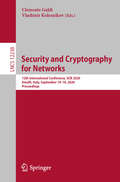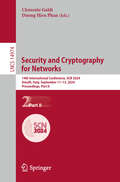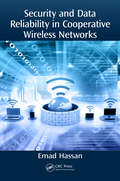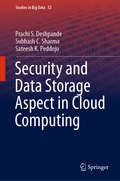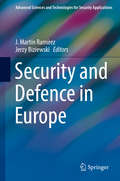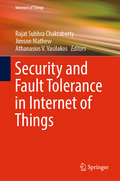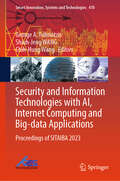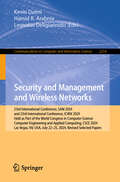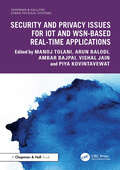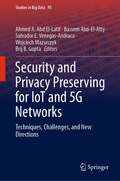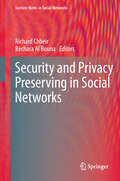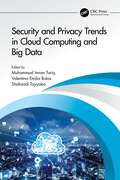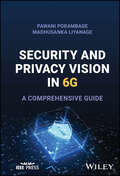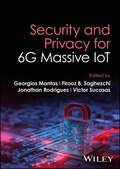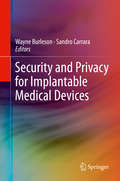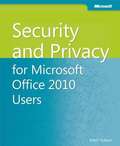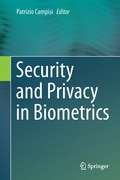- Table View
- List View
Security and Cryptography for Networks: 12th International Conference, SCN 2020, Amalfi, Italy, September 14–16, 2020, Proceedings (Lecture Notes in Computer Science #12238)
by Vladimir Kolesnikov Clemente GaldiThis book constitutes the proceedings of the 12th International Conference on Security and Cryptography for Networks, SCN 2020, held in Amalfi, Italy, in September 2020*.The 33 papers presented in this volume were carefully reviewed and selected from 87 submissions. They are organized in topical sections on blockchain; multiparty computation; oblivious RAM; primitives and constructions; signatures, encryption, and algebraic constructions; symmetric crypto; theory and lower bounds ; zero-knowledge. *The conference was held virtually due to the COVID-19 pandemic.
Security and Cryptography for Networks: 13th International Conference, SCN 2022, Amalfi (SA), Italy, September 12–14, 2022, Proceedings (Lecture Notes in Computer Science #13409)
by Stanislaw Jarecki Clemente GaldiThis book constitutes the proceedings of the 13th International Conference on Security and Cryptography for Networks, SCN 2022, held in Amalfi, Italy, in September 2022. The 33 full papers presented in this volume were carefully reviewed and selected from 101 submissions. They are organized in topical sections: Ciphers, Cryptanalysis, Defenses; Public Key Encryption; Authentication and Signatures, Multiparty Computation; Zero-Knowledge Proofs and Applications.
Security and Cryptography for Networks: 14th International Conference, SCN 2024, Amalfi, Italy, September 11–13, 2024, Proceedings, Part I (Lecture Notes in Computer Science #14973)
by Clemente Galdi Duong Hieu PhanThe two-volume set LNCS 14973 and 14974 constitutes the proceedings of the 14th International Conference on Security and Cryptography for Networks, SCN 2024, which took place in Amalfai, Italy, during September 11-13, 2024. The 33 full papers included in the proceedings were carefully reviewed and selected from 90 submissions. They were organized in topical sections as follows: Part I: Zero Knowledge; foundations; protocols; voting systems; Part II: Homomorphic encryption; symmetric key encryption; cryptanalysis; key management; blockchains.
Security and Cryptography for Networks: 14th International Conference, SCN 2024, Amalfi, Italy, September 11–13, 2024, Proceedings, Part II (Lecture Notes in Computer Science #14974)
by Clemente Galdi Duong Hieu PhanThe two-volume set LNCS 14973 and 14974 constitutes the proceedings of the 14th International Conference on Security and Cryptography for Networks, SCN 2024, which took place in Amalfai, Italy, during September 11-13, 2024. The 33 full papers included in the proceedings were carefully reviewed and selected from 90 submissions. They were organized in topical sections as follows: Part I: Zero Knowledge; foundations; protocols; voting systems; Part II: Homomorphic encryption; symmetric key encryption; cryptanalysis; key management; blockchains.
Security and Data Reliability in Cooperative Wireless Networks
by Emad HassanFollowing a detailed overview of cooperative communications and the physical layer security, this book proposes relay and jammer selection schemes for security in one-way cooperative networks and to improve physical layer security in two-way cooperative networks. It also proposes a Cooperative Hybrid Self-Healing scheme to enhance the confidentiality of the data collected by UWSN. It ends with a proposal called Self-Healing Cluster Controlled Mobility (SH-CCM) scheme based on hybrid cooperation between both Proactive and Reactive peers and the sick sensors at both network and cluster levels to guarantee the security in UWSN.
Security and Data Storage Aspect in Cloud Computing (Studies in Big Data #52)
by Prachi S. Deshpande Subhash C. Sharma Sateesh K. PeddojuThis book analyses the various security threats in cloud computing. A host-based IDS (HIDS) using signature verification is developed and implemented for the concerned security issues. Further, owing to the vulnerability of distributed denial of service (DDoS) attacks in cloud computing, a network based IDS (NIDS) is developed and implemented against such attacks. The performance of these IDS is verified in the Cloud scenario as well against the standard data set. Finally, a simple data storage and security model is developed and implemented for the Cloud computing scenario. The contents of this book will be of interest to researchers and professionals alike.
Security and Defence in Europe (Advanced Sciences and Technologies for Security Applications)
by J. Martín Ramírez Jerzy BiziewskiThis book argues that security and defense have never been true priorities in the European Union, and have constantly been marginalized by the elites since the Soviet Union collapsed and the Warsaw Pact disintegrated. Despite the official rhetoric, only a few tangible results can be presented concerning the operational readiness of European forces, and the EU’s inability to act was proven during the crises in the Balkans, NATO has experienced similar problems, as the majority of its members are EU countries. Both organizations have declared their resolve concerning the security and defense of their nations and territories, but, unfortunately, little has been done to lend these statements credence. In this context, the book analyzes several aspects of EU security and defense, including: the EU – NATO relationship, common defense policy and strategy, common capability building, common understanding of strategic changes, common operational planning and centrally synchronized exercises based on operational planning, etc. The member states have helped to make EU/NATO effective organizations, but unfortunately their individual interests and priorities constitute real challenges. This aspect should be discussed and addressed by political and military elites, scholars, analysts, students and the general public alike.
Security and Fault Tolerance in Internet of Things (Internet of Things)
by Rajat Subhra Chakraborty Athanasios V. Vasilakos Jimson MathewThis book covers various aspects of security, privacy and reliability in Internet of Things (IoT) and Cyber-Physical System design, analysis and testing. In particular, various established theories and practices both from academia and industry are presented and suitably organized targeting students, engineers and researchers. Fifteen leading academicians and practitioners wrote this book, pointing to the open problems and biggest challenges on which research in the near future will be focused.
Security and Information Technologies with AI, Internet Computing and Big-data Applications: Proceedings of SITAIBA 2023 (Smart Innovation, Systems and Technologies #410)
by George A. Tsihrintzis Shiuh-Jeng Wang Chih-Hung WangThe book presents selected papers from Second International Conference on Security and Information Technologies with AI, Internet Computing and Big-Data Applications (SITAIBA 2023), held at Chihlee University of Technology, New Taipei City during 7 – 9 December 2023. This book presents current research in information security, AI and deep learning applications, information processing, cyber-security and evidence investigations, and information hiding and cryptography.
Security and Management and Wireless Networks: 23rd International Conference, SAM 2024 and 23rd International Conference, ICWN 2024, Held as Part of the World Congress in Computer Science, Computer Engineering and Applied Computing, CSCE 2024, Las Vegas, NV, USA, July 22–25, 2024, Revised Selected Papers (Communications in Computer and Information Science #2254)
by Hamid R. Arabnia Kevin Daimi Leonidas DeligiannidisThis book constitutes the proceedings of the 23rd International Conference on Security and Management, SAM 2024, and the 23rd International Conference on Wireless Networks, ICWN 2024, held as part of the 2024 World Congress in Computer Science, Computer Engineering and Applied Computing, in Las Vegas, USA, during July 22 to July 25, 2024. For SAM 2024, 255 submissions have been received and 40 papers have been accepted for publication in these proceedings; the 12 papers included from IWCN 2024 have been carefully reviewed and selected from 66 submissions. They have been organized in topical sections as follows: Intrusion and attack detection: malware, malicious URL, phishing; security assessment and management + blockchain + use of artificial intelligence; cybersecurity and communications systems + cryptography and privacy; security and management + new methodologies and applications; wireless networks and mobile computing.
Security and Microservice Architecture on AWS: Architecting and Implementing a Secured, Scalable Solution
by Gaurav RajeSecurity is usually an afterthought when organizations design microservices for cloud systems. Most companies today are exposed to potential security threats, but their responses are often more reactive than proactive. This leads to unnecessarily complicated systems that are hard to implement and even harder to manage and scale. Author Gaurav Raje shows you how to build highly secure systems on AWS without increasing overhead.Ideal for cloud solution architects and software developers with AWS experience, this practical book starts with a high-level architecture and design discussion, then explains how to implement your solution in the cloud while ensuring that the development and operational experience isn't compromised. By leveraging the AWS Shared Responsibility Model, you'll be able to:Develop a modular architecture using microservices that aims to simplify compliance with various regulations in finance, medicine, and legal servicesIntroduce various AWS-based security controls to help protect your microservices from malicious actorsLeverage the modularity of the architecture to independently scale security mechanisms on individual microservicesImprove the security posture without compromising the autonomy or efficiency of software development teams
Security and Organization within IoT and Smart Cities
by Kayhan Zrar Ghafoor, Kevin Curran, Linghe Kong and Ali Safaa SadiqThis book aims to provide the latest research developments and results in the domain of AI techniques for smart cyber ecosystems. It presents a holistic insight into AI-enabled theoretic approaches and methodology in IoT networking, security analytics using AI tools, and network automation, which ultimately enable intelligent cyber space. This book will be a valuable resource for students, researchers, engineers, policy makers working in various areas related to cybersecurity and privacy for Smart cities. This book includes chapters titled “An Overview of the Artificial Intelligence Evolution and its Fundamental Concepts, and their relationship with IoT Security”, “Smart City: Evolution and fundamental concepts”, “Advances in AI-Based Security for Internet of Things in Wireless Virtualization Environment”, “A conceptual model for optimal resource sharing of networked microgrids focusing uncertainty – paving path to eco-friendly smart cities”, “A Novel Framework for Cyber Secure Smart City", “Contemplate Security Challenges & Threats for Smart Cities”, “Self-Monitoring Obfuscated IoT Network”, “Introduction to Side Channel Attacks and Investigation of Power Analysis & Fault Injection Attack Techniques”, “Collaborative Digital Forensic Investigations Model for Law Enforcement: Oman as a Case Study”, “Internet of Things Security and Privacy in Smart Cities: Status and Challenges”, “5G Security and the Internet of Things”, “The Problem of Deepfake Videos and How to Counteract Them in Smart Cities”, “The Rise of Ransomware aided by Vulnerable IoT devices”, and “Security Issues in Self-Driving Cars within Smart Cities”, “PhishFree: A Honeybee Inspired System for Smart City Free of Phishing Attacks”, “Trust Aware Crowd Associated Network-based Approach for Optimal Waste Management in Smart Cities” This book provides state-of-the-art of research results and discusses current issues, challenges, solutions and recent trends related to security and organization within IoT and Smart Cities. We expect this book to be of significant importance not only to researchers and practitioners in academia, government agencies and industries, but also for policy makers and system managers. We anticipate this book to be a valuable resource for all those working in this new and exciting area, and a “must have” for all university libraries.
Security and Policy Driven Computing
by Lei LiuSecurity and Policy Driven Computing covers recent advances in security, storage, parallelization, and computing as well as applications. The author incorporates a wealth of analysis, including studies on intrusion detection and key management, computer storage policy, and transactional management.The book first describes multiple variables and ind
Security and Privacy Issues for IoT and WSN-based Real-time Applications (Chapman & Hall/CRC Cyber-Physical Systems)
by Vishal Jain Ambar Bajpai Arun Balodi Manoj TolaniThis book explores the security and privacy challenges associated with real-time applications of the Internet of Things (IoT) and wireless sensor networks (WSN) technologies. It provides detailed insights into the unique security and privacy concerns, such as malicious attacks, data breaches, insider threats, and privacy breaches, that arise in the context of real-time applications, like in smart homes, smart cities, industrial automation, healthcare, and other time-sensitive domains to offer practical solutions and strategies to mitigate these risks. Covers various aspects of security and privacy, including authentication, access control, data integrity, confidentiality, availability, threat detection and mitigation, privacy-preserving techniques Investigates the possibilities of cross-layer approaches to address the specific requirements of real-time applications and develop innovative solutions Gaining insights into fundamental limits through information-theoretic research, new protocol designs are developed to access the medium in an energy-efficient manner to improve the performance and reliability of WSN and IoT networks for real-time applications Discusses the sustainable requirements of emerging real-time applications, such as low energy consumption and high data rates Offers an interdisciplinary approach that encompasses areas of communication, networking, and information theory to guide real-life deployment of IoT/ WSN-based monitoring systems It is a valuable reference for readers who want to gain a deeper understanding of the challenges and solutions related to the security and privacy of IoT and WSN in the context of real-time applications.
Security and Privacy Preserving for IoT and 5G Networks: Techniques, Challenges, and New Directions (Studies in Big Data #95)
by Wojciech Mazurczyk Brij B. Gupta Ahmed A. Abd El-Latif Bassem Abd-El-Atty Salvador E. Venegas-AndracaThis book presents state-of-the-art research on security and privacy- preserving for IoT and 5G networks and applications. The accepted book chapters covered many themes, including traceability and tamper detection in IoT enabled waste management networks, secure Healthcare IoT Systems, data transfer accomplished by trustworthy nodes in cognitive radio, DDoS Attack Detection in Vehicular Ad-hoc Network (VANET) for 5G Networks, Mobile Edge-Cloud Computing, biometric authentication systems for IoT applications, and many other applications It aspires to provide a relevant reference for students, researchers, engineers, and professionals working in this particular area or those interested in grasping its diverse facets and exploring the latest advances on security and privacy- preserving for IoT and 5G networks.
Security and Privacy Preserving in Social Networks
by Richard Chbeir Bechara Al BounaThis volume aims at assessing the current approaches and technologies, as well as to outline the major challenges and future perspectives related to the security and privacy protection of social networks. It provides the reader with an overview of the state-of-the art techniques, studies, and approaches as well as outlining future directions in this field. A wide range of interdisciplinary contributions from various research groups ensures for a balanced and complete perspective.
Security and Privacy Trends in Cloud Computing and Big Data
by Muhammad Imran TariqIt is essential for an organization to know before involving themselves in cloud computing and big data, what are the key security requirements for applications and data processing. Big data and cloud computing are integrated together in practice. Cloud computing offers massive storage, high computation power, and distributed capability to support processing of big data. In such an integrated environment the security and privacy concerns involved in both technologies become combined. This book discusses these security and privacy issues in detail and provides necessary insights into cloud computing and big data integration. It will be useful in enhancing the body of knowledge concerning innovative technologies offered by the research community in the area of cloud computing and big data. Readers can get a better understanding of the basics of cloud computing, big data, and security mitigation techniques to deal with current challenges as well as future research opportunities.
Security and Privacy Trends in the Industrial Internet of Things (Advanced Sciences and Technologies for Security Applications)
by Cristina AlcarazThis book, written by leaders in the protection field of critical infrastructures, provides an extended overview of the technological and operative advantages together with the security problems and challenges of the new paradigm of the Internet of Things in today’s industry, also known as the Industry Internet of Things (IIoT). The incorporation of the new embedded technologies and the interconnected networking advances in the automation and monitoring processes, certainly multiplies the functional complexities of the underlying control system, whilst increasing security and privacy risks. The critical nature of the application context and its relevance for the well-being of citizens and their economy, attracts the attention of multiple, advanced attackers, with stealthy abilities to evade security policies, ex-filter information or exploit vulnerabilities. Some real-life events and registers in CERTs have already clearly demonstrated how the control industry can become vulnerable to multiple types of advanced threats whose focus consists in hitting the safety and security of the control processes. This book, therefore, comprises a detailed spectrum of research papers with highly analytical content and actuation procedures to cover the relevant security and privacy issues such as data protection, awareness, response and resilience, all of them working at optimal times. Readers will be able to comprehend the construction problems of the fourth industrial revolution and are introduced to effective, lightweight protection solutions which can be integrated as part of the new IIoT-based monitoring ecosystem.
Security and Privacy Vision in 6G: A Comprehensive Guide
by Madhusanka Liyanage Pawani PorambageSECURITY AND PRIVACY VISION IN 6G Prepare for the future of mobile communication with this comprehensive study 6G is the next frontier in mobile communication, with development of 6G standards slated to begin as early as 2026. As telecommunications networks become faster and more intelligent, security and privacy concerns are critical. In an increasingly connected world, there is an urgent need for user data to be safeguarded and system security enhanced against a new generation of threats. Security and Privacy Vision in 6G provides a comprehensive survey of these threats and the emerging techniques for safeguarding against them. It includes mechanisms for prediction, detection, mitigation, and prevention, such that threats to privacy and security can be forestalled at any stage. Fully engaged with proposed 6G architectures, it is an essential resource for mobile communications professionals looking for a head start on the technology of the future. Security and Privacy Vision in 6G readers will also find: Detailed coverage of topics including edge intelligence and cloudification, industrial automation, collaborative robots, and more Treatment balancing the practical and the theoretical An editorial team with decades of international network technology experience in both industry and academia Security and Privacy Vision in 6G is a vital reference for network security professionals and for postgraduate and advanced undergraduate students in mobile communications and network security-related fields.
Security and Privacy for 6G Massive IoT
by Jonathan Rodriguez Victor Sucasas Georgios Mantas Firooz B. SaghezchiAnticipate the security and privacy threats of the future with this groundbreaking text The development of the next generation of mobile networks (6G), which is expected to be widely deployed by 2030, promises to revolutionize the Internet of Things (IoT), interconnecting a massive number of IoT devices (massive IoT) on a scale never before envisioned. These devices will enable the operation of a wide spectrum of massive IoT applications such as immersive smart cities, autonomous supply chain, flexible manufacturing and more. However, the vast number of interconnected IoT devices in the emerging massive IoT applications will make them vulnerable to an unprecedented variety of security and privacy threats, which must be anticipated in order to harness the transformative potential of these technologies. Security and Privacy for 6G Massive IoT addresses this new and expanding threat landscape and the challenges it poses for network security companies and professionals. It offers a unique and comprehensive understanding of these threats, their likely manifestations, and the solutions available to counter them. The result creates a foundation for future efforts to research and develop further solutions based on essential 6G technologies. Readers will also find: Analysis based on the four-tier network architecture of 6G, enhanced by Edge Computing and Edge Intelligence Detailed coverage of 6G enabling technologies including blockchain, distributed machine learning, and many more Scenarios, use cases, and security and privacy requirements for 6G Massive IoT applications Security and Privacy for 6G Massive IoT is ideal for research engineers working in the area of IoT security and designers working on new 6G security products, among many others.
Security and Privacy for Implantable Medical Devices
by Sandro Carrara Wayne BurlesonThis book presents a systematic approach to analyzing the challenging engineering problems posed by the need for security and privacy in implantable medical devices (IMD). It describes in detail new issues termed as lightweight security, due to the associated constraints on metrics such as available power, energy, computing ability, area, execution time, and memory requirements. Coverage includes vulnerabilities and defense across multiple levels, with basic abstractions of cryptographic services and primitives such as public key cryptography, block ciphers and digital signatures. Experts from Computer Security and Cryptography present new research which shows vulnerabilities in existing IMDs and proposes solutions. Experts from Privacy Technology and Policy will discuss the societal, legal and ethical challenges surrounding IMD security as well as technological solutions that build on the latest in Computer Science privacy research, as well as lightweight solutions appropriate for implementation in IMDs.
Security and Privacy for Microsoft® Office 2010 Users
by Mitch TullochThis title is also available as a free eBook. Take control--and put the built-in security and privacy features in Microsoft Office to work! Whether downloading documents, publishing a presentation, or collaborating online--this guide offers concise, how-to guidance and best practices to help protect your documents and your ideas.Get practical, proactive guidance for using the security and privacy management features in Office 2010 and Office 365 Walk through everyday scenarios, and discover everyday techniques that help you take charge Understand common risks and learn best practices you can apply right away
Security and Privacy for Modern Networks: Strategies and Insights for Safeguarding Digital Infrastructures
by Seshagirirao Lekkala Priyanka GurijalaThis book reviews how to safeguard digital network infrastructures, emphasizing on the latest trends in cybersecurity. It addresses the evolution of network systems, AI-driven threat detection, and defense mechanisms, while also preparing readers for future technological impacts on security. This concise resource is essential to understanding and implementing advanced cyber defense strategies in an AI-integrated world. Readers are provided with methods and tips on how to evaluate the efficacy, suitability, and success of cybersecurity methods and AI/machine learning applications to safeguard their networks. Case studies are included; with examples of how security gaps have led to security breaches and how the methods discussed in the book would help combat these. This book is intended for those who wish to understand the latest trends in network security. It provides an exploration of how AI is revolutionizing cyber defense, offering readers from various fields including insights into strengthening security strategies. With its detailed content, the book empowers its audience to navigate complex regulations and effectively protect against a landscape of evolving cyber threats, ensuring they are well-equipped to maintain robust security postures within their respective sectors. What You Will Learn: The transformative role AI plays in enhancing network security, including threat detection, pattern recognition, and automated response strategies. Cutting-edge security protocols, encryption techniques, and the deployment of multi-layered defense systems for robust network protection. Insights into vulnerability assessments, risk analysis, and proactive measures to prevent and mitigate cyber threats in modern network environments. Who This Book is for: IT professionals and network administrators, cybersecurity specialists and analysts, students and researchers in computer science or cybersecurity programs, corporate decision-makers and C-level executives responsible for overseeing their organizations' security posture. Also security architects and engineers designing secure network infrastructures, government and defense agency personnel tasked with protecting national and organizational cyber assets. Finally technology enthusiasts and hobbyists with a keen interest in cybersecurity trends and AI developments and professionals in regulatory and compliance roles requiring an understanding of cybersecurity challenges and solutions.
Security and Privacy for Next-Generation Wireless Networks (Wireless Networks)
by Lei Xie Xinyi Huang Sheng Zhong Kun Wang Hong Zhong Panlong Yang Jin ShiThis timely book provides broad coverage of security and privacy issues in the macro and micro perspective. In macroperspective, the system and algorithm fundamentals of next-generation wireless networks are discussed. In micro-perspective, this book focuses on the key secure and privacy techniques in different emerging networks from the interconnection view of human and cyber-physical world. This book includes 7 chapters from prominent international researchers working in this subject area. This book serves as a useful reference for researchers, graduate students, and practitioners seeking solutions to wireless security and privacy related issues Recent advances in wireless communication technologies have enabled the large-scale deployment of next-generation wireless networks, and many other wireless applications are emerging. The next generation of mobile networks continues to transform the way people communicate and access information. As a matter of fact, next-generation emerging networks are exploiting their numerous applications in both military and civil fields. For most applications, it is important to guarantee high security of the deployed network in order to defend against attacks from adversaries, as well as the privacy intrusion. The key target in the development of next-generation wireless networks is to promote the integration of the human, cyber, and physical worlds. Previous work in Cyber Physical Systems (CPS) considered the connection between the cyber world and the physical world. In the recent studies, human involvement brings new channels and initiatives in this interconnection. In this integration process, security and privacy are critical issues to many wireless network applications, and it is a paramount concern for the growth of next-generation wireless networks. This is due to the open nature of wireless communication and the involvement of humans. New opportunities for tackling these security and privacy issues in next-generation wireless networks will be achieved by leveraging the properties of interaction among human, computers and things.
Security and Privacy in Biometrics
by Patrizio CampisiThis important text/reference presents the latest secure and privacy-compliant techniques in automatic human recognition. Featuring viewpoints from an international selection of experts in the field, the comprehensive coverage spans both theory and practical implementations, taking into consideration all ethical and legal issues. Topics and features: presents a unique focus on novel approaches and new architectures for unimodal and multimodal template protection; examines signal processing techniques in the encrypted domain, security and privacy leakage assessment, and aspects of standardization; describes real-world applications, from face and fingerprint-based user recognition, to biometrics-based electronic documents, and biometric systems employing smart cards; reviews the ethical implications of the ubiquity of biometrics in everyday life, and its impact on human dignity; provides guidance on best practices for the processing of biometric data within a legal framework.
